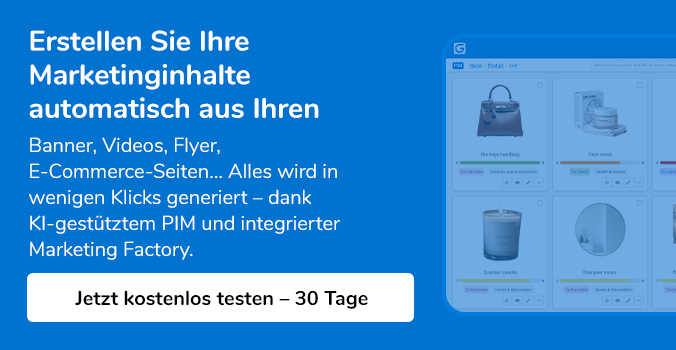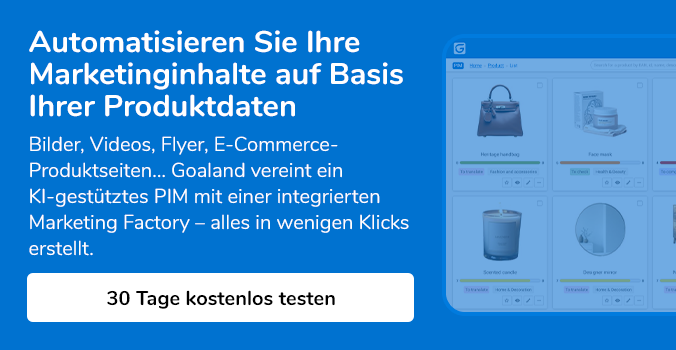In today's ultra-competitive environment, diversification of the product offer has become essential to remain competitive: over 25% of a company's global revenues and profits1 are generated by the launch of new products.
This means that company's are having to manage and update product information relating to a large number of product references: codes (EAN, GTIN, SKU…), technical features, prices, marketing descriptions…
To meet this challenge, implementing a product repository greatly increases the efficiency of product information management and accelerates the commercialization of new products.
Read the detailed definition of a product repository and all the benefits it will bring to your company.
#Product repository: definition
The quantity of product data is constantly increasing2 within companies. Managing it requires various systems: ERP (Enterprise Resource Planning), CRM (Customer Relationship Management), files in different formats (Excel, XML, Json…). This scattering of information sources makes it almost impossible to maintain a reliable and consistent version of product information: 48% of businesses3 say that this is the case for them.
A product repository allows you to store and centralize all your product related data (marketing, technical, logistics …) in one unique system. The implementation of this repository is part of a more global action for improving business processes. The product repository facilitates team collaboration, provides a 360° view of product data, and improves the control of data quality: structure, find and eliminate duplicates, correct errors, enrich information…
#The advantages of using a product repository
#Reduction in errors in product information
Businesses often manage their product information through Excel: 94% of businesses4 use Excel, 56%4 regularly identify errors in their product datasheets, and only 6%4 consider that the information is reliable.

Using Excel requires that teams input attributes manually into each product datasheet (35%5) and product information into product families and categories (21%5). Multiplying manual input in several different Excel files, increases the occurrence of errors in product information: data duplicates, incorrect price input, inaccurate image sizes, inconsistencies…
Implementing a product repository eliminates these errors as it contains the most reliable and up to date version of product data and allows product and marketing teams to rely on accurate and updated product data, at all times, for the creation of their product datasheets. This process improves the quality of product information by (66%6) and reduces errors in the information by (36%5).
#Improved standardization of product data
Product information comes from various information sources7 and is often « raw7 » and presented in assorted formats: 72% of this data5 comes from supplier product catalogs and is therefore « non-standardized ».
Implementing a product repository allows you to structure data and standardize it according to common specifications: naming rules, standards, format requirements… This work on the data collected from different information sources unifies4 the company's « marketing comunication » and guarantees consistent information8 across the different selling channels: eCommerce, mobile, print, points of sale…
#Reduced Time To Market
To sell a new product, different professions4 (product manager, marketing manager, supplier…) must be able to work together and have constant access to the information they need to prepare the product release. This is one of the 4 key levers9 involved in reducing the time to market.

The product repository activates this lever and enables product and marketing teams to anticipate the product launch. The repository provides them with quick access4 to the correct product information and allows them to make the necessary changes to the brand's product catalog: add a new product, update product information, edit prices… They can now produce a product catalog in « just a few days4 » when previously the process could take « several months ». This improved productivity reduces the Time To Market4 of your products.
#PIM: the company's central product repository
PIM (Product Information Management) solutions centralize all of the Information System's (IS) third-party applications. They retrieve and synchronize the product data contained in these applications to become the company's unique product reference source.
This also means that PIM federates different teams (Product, Marketing, sales, SEO…) around a unique product repository. Multi-user management features allow them to work together to improve the quality of product information. Depending on their user rights, each contributor can change, enrich and/or contextualize product information. A workflow engine also provides visibility over the completeness of data before distribution across the different selling channels.
With this improved productivity, PIM provides numerous advantages: better operational efficiency (67%5), higher conversion rate (27%5), increased agility (22%5)… It also allows you to react more quickly than your competitors and significantly accelerate the time to market5 of new products.
1
Grüntges, V. G. (2017, October 13). How to make sure your next product or service launch drives growth. mckinsey.com.
2
Montérémal, J. M. (2021, December 13). Ne vous noyez plus sous la donnée produit. Valorisez-la grâce au Product Information Management. appvizer.fr.
3
Ventana Research. Mastering Product Information is Everyone's Business. slideshare.net.
4
Lamellière, F. L. (2016, March 1). Comment l'optimisation de l'information produit accélère le Time To market. journaldunet.com.
5
STIBO SYSTEMS. (2021, September). PXM : L'expérience produit au service de l'expérience client. stibosystems.com.
6
Ventana Research. Building a Business Case for PIM. ventanaresearch.com.
7
Lucas, S. L. Les 5 clés de la réussite d'un projet Product Information Management (PIM). journaldunet.com.
8
Paupier, F. P. (2020, December 10). Quelle solution PIM pour maîtriser l'information produit ? appvizer.fr.
9
IAC partners. Accélérer son time to market. iacpartners.com.







